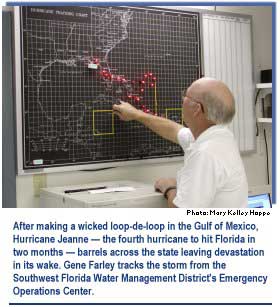|
 Behind the Curtain and at the Controls: Behind the Curtain and at the Controls:
Gene Farley
By Mary Kelley Hoppe
The Wizard of Oz operates out of a one-story flat-top compound on the Brooksville campus of the Southwest Florida Water Management District. The only hint of the goings-on inside is the roof-top satellite dish trained to the heavens, continuously downloading weather data. It's been an unusually busy season - bracing for hurricanes Charley, Frances, Ivan and Jeanne - but Gene Farley takes it in stride. From his office inside the Emergency Operations Center, or EOC, Farley is the wizard who controls the district's 80 water structures, from the behemoth Structure 162 on the Tampa Bypass Canal - with seven 12 x 28-foot hydraulic lift gates that hold up to 22,000 cubic feet of water per second - to simple hand-operated stack-log gates.
So behind the scenes is he that Farley's wife hasn't even seen him in daylight for weeks.
On the day of my first visit in early September, Frances is bearing down on Florida and the current track puts it on a direct course for Brooksville.
The district EOC has not yet been activated, a formal process that sets in motion round-the-clock personnel staggered in 12-hour shifts. That decision must come from executive director Dave Moore, who is awaiting a weather update. Farley punches up the latest track and sends a printout to the executive suite.
The district operates surface water control structures on lakes and rivers spread over a 16-county region, from Levy County south to Charlotte Harbor and inland to Polk County. Most are designed to conserve water for potable use and wetland replenishment; fewer than 10 are for flood control.
Farley watches over his brood from a laptop computer, rising sometimes in the middle of the night, particularly in storm season, to sneak a peak. At the click of a button, he can call up and access real-time water levels for any structure, and raise or lower the gates at the 20 or so that are now fully automated.
Keeping tabs on water levels are hundreds of devices pulling data from nearly a thousand individual sensors. The Supervisory Control and Data Acquisition (SCADA) system continuously transmits information on rainfall, water levels and other hydrological conditions - which in turn enables the district to supply critical rainfall information to the National Weather Service, Army Corps of Engineers, county EOCs and local media.
Alarms provide early warning of rising water levels. It's a far cry but just a short hop from how things used to be. Not long ago even the major flood gates were operated manually. That meant dispatching field reps to troubleshoot systems and regulate water levels by hand, sometimes in dangerous storms.
Farley recalls one especially harrowing experience in 1997.
"It was 3 o'clock in the morning, the rain was blowing sideways, lightning was everywhere - and we were on the water down at 160 (the Tampa Bypass canal)," he said. "We were operating the gates by hand, and I had a flashlight 'cause I couldn't see the controls."
For three months solid as El Nino rains pounded the region, the District had someone on site every day. "We were discharging about eight billion gallons of water per day," says Farley. "Water was roaring past the lift gates."
A single potentially dangerous operation that took hours less than a decade ago is accomplished in a matter of seconds today by computer.
Farley wrote the design for a basic electrical activation system used to pull up the gates at the first sites to be fully automated, three smaller structures near Carrollwood, saving the District about $15,000 over outside estimates.
But even dams with automatic controls and backup generators can fail, as a dozen Rocky Creek residents learned when power outages following torrential rains from Hurricane Jeanne caused a floodgate malfunction. Homes flooded when getting someone on site in dangerous weather fast enough to correct the problem proved difficult; the District is evaluating its backup procedures in the wake of the incident.
With a beeper and cell phone linked to SCADA, Farley is well connected. The system rings his home and pages him with warnings. "It's a nasty little voice you don't want to hear at 2, 3 or 4 o'clock in the morning."
|

